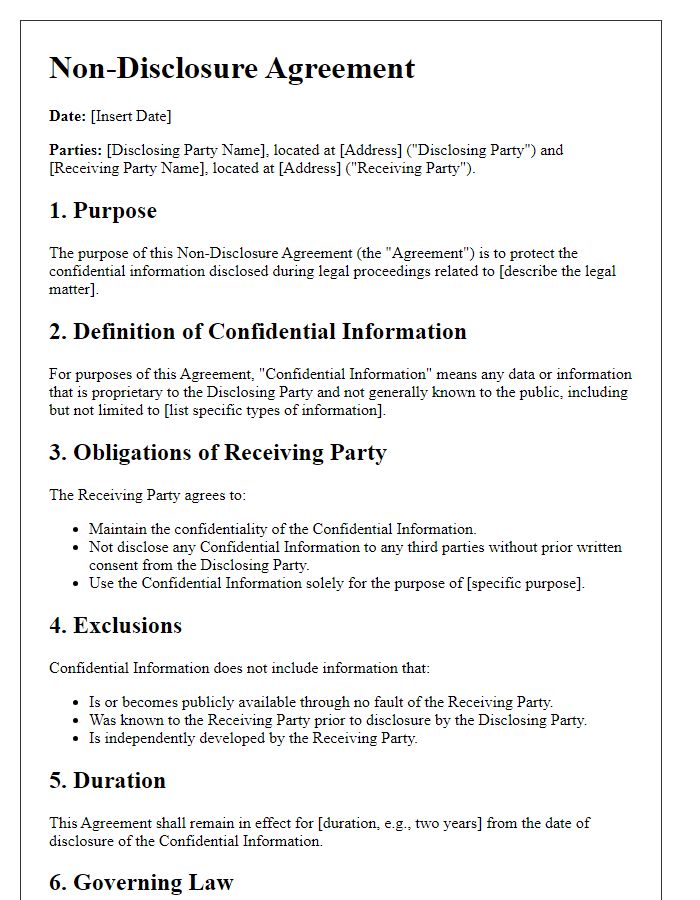Are you looking to draft a solid confidentiality agreement for a legal matter? It's crucial to ensure that all parties involved understand the importance of keeping sensitive information secure. A well-structured letter template can guide you through the necessary components, offering clarity and protection for everyone involved. So, let's dive into the essentials of creating your confidentiality agreement and explore how to tailor it to your specific needs!

Parties Involved: Identifying the parties entering the agreement.
The confidentiality agreement involves two primary parties: the Disclosing Party, typically a corporation or individual sharing sensitive information, and the Receiving Party, another corporation or individual agreeing to protect that information. The agreement often stipulates specific identifiers, such as legal names, business addresses, and identification numbers, to eliminate ambiguity. The purpose of the agreement is to ensure the unauthorized disclosure of proprietary information, trade secrets, or personal data does not occur. Any breach by either party may result in legal consequences, including monetary penalties and litigation costs. Legal jurisdictions, such as state or federal laws applicable to confidentiality agreements, may also influence the terms and enforceability of the agreement.
Definition of Confidential Information: Clearly specifying what constitutes confidential data.
A confidentiality agreement must include a detailed definition of Confidential Information to protect sensitive data effectively. Confidential Information encompasses proprietary data, business strategies, trade secrets, financial records, client lists, and any information shared in written, oral, or electronic form (such as emails). Specificity is crucial; for instance, customer identities or pricing models related to a company's operations in the competitive market (like the tech industry valued at trillions of dollars) should be explicitly defined. This definition should also clarify exclusions, such as information publicly available or independently developed without breach of the agreement, ensuring a comprehensive understanding of what is protected under the confidentiality terms.
Obligations of Receiving Party: Duties regarding handling and protection of information.
The Receiving Party in a confidentiality agreement has specific obligations to ensure the protection of confidential information shared during legal matters. This includes safeguarding sensitive data such as personal identifiers, proprietary business information, and legal documents from unauthorized access, sharing, or disclosure. The Receiving Party must implement strict data security measures, including encryption protocols and access controls, to prevent breaches. Effective training and awareness programs regarding confidentiality standards are essential for all personnel who handle confidential information. Moreover, any unauthorized use or transfer of the information must be reported immediately, and the Receiving Party is responsible for returning or destroying the confidential materials upon termination of the agreement or at the request of the Disclosing Party. These duties not only serve to maintain trust but also ensure compliance with legal standards regarding data protection, such as the General Data Protection Regulation (GDPR) in Europe or the Health Insurance Portability and Accountability Act (HIPAA) in the United States.
Duration of Confidentiality: Time period during which confidentiality is maintained.
Duration of Confidentiality refers to the specific time frame during which all parties involved in the confidentiality agreement must refrain from disclosing, sharing, or utilizing confidential information. This duration can vary significantly, typically ranging from one year to five years following the termination of the agreement or the conclusion of the related business transaction. It ensures that sensitive data, such as proprietary business strategies, trade secrets, client information, or intellectual property, remains protected from unauthorized access or disclosure. The duration is crucial for safeguarding competitive advantage and maintaining trust in business relationships, particularly in industries like technology, pharmaceuticals, and finance, where confidentiality plays a vital role. Additionally, the duration may be extended for certain types of information requiring longer protection, emphasizing the importance of clearly defining this element within the agreement to prevent any potential legal disputes or misunderstandings.
Consequences of Breach: Legal implications and remedies if terms are violated.
A breach of a confidentiality agreement can lead to significant legal implications for the offending party, including potential monetary damages. For instance, parties may be liable for direct and consequential damages incurred by the non-breaching party, which can include lost profits or additional costs associated with protective measures or litigation. Legal remedies may involve injunctive relief, preventing further unauthorized disclosure of confidential information, and requiring the return or destruction of such information. Additionally, punitive damages may be sought in cases of willful misconduct or gross negligence, emphasizing the importance of upholding the terms of the agreement. Jurisdictional laws, such as those in California or New York, may provide varying enforcement mechanisms and precedents regarding the breach, influencing outcomes in legal proceedings. Confidentiality agreements serve to protect sensitive information in business environments, including trade secrets, client lists, or proprietary technology, making adherence crucial for maintaining competitive advantage.













Comments